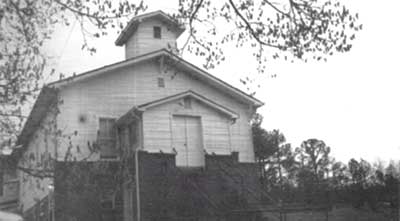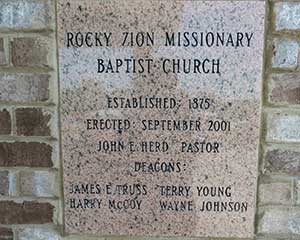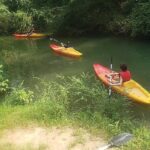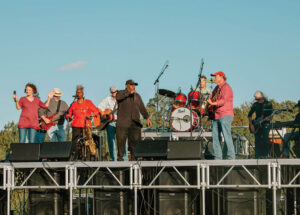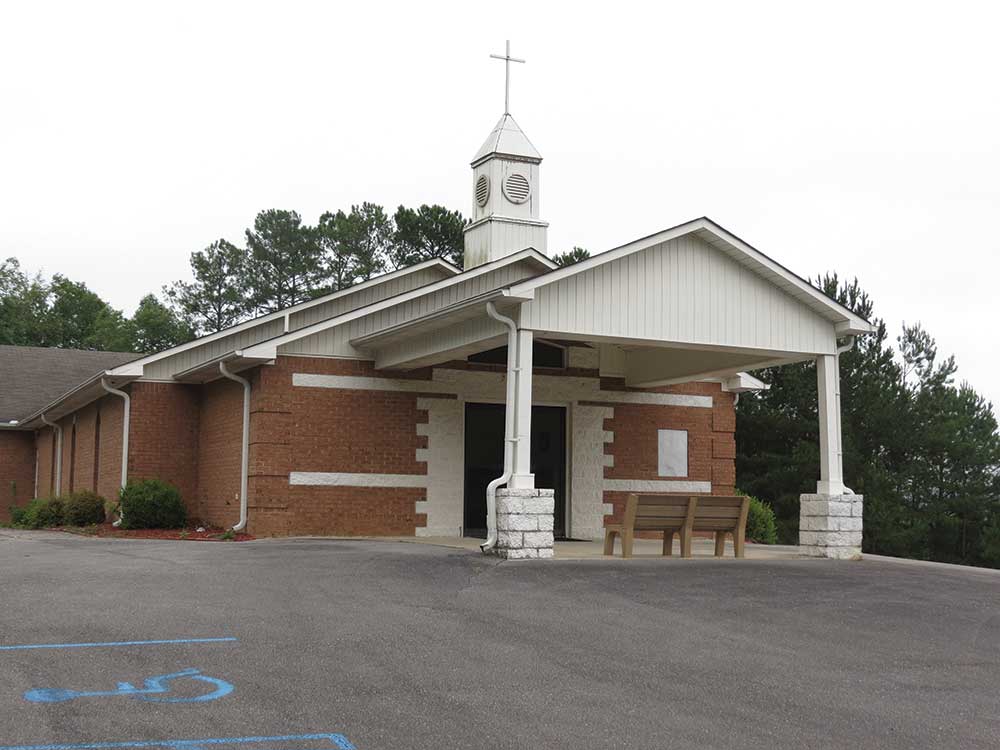
More than 100 years of worship, community
Story by Joe Whitten
Submitted Photos
A sweeping driveway and parking lot lead one up to Rocky Zion Missionary Baptist Church’s brick sanctuary on 16th Street South in Pell City overlooking The Legacy Center and a community of interconnecting streets.
Before integration of schools, today’s Legacy Center was the location of the St. Clair County Training School, serving Black students locally as well as those from Moody, Margaret, and Ragland.
Today, no one knows how the name “Rocky Zion” was chosen, although one can speculate. In the Old Testament, “Zion” was another name for Jerusalem, the City of God. In the Christian era, Zion referred to the New Jerusalem, Heaven.
The old hymn, Marching to Zion, speaks of “marching upward to Heaven, the beautiful City of God. But how does “Rocky” come in? There does not seem to be a definitive answer but considering that the church was organized by freed slaves during the last year of Reconstruction in Alabama and scarcely 11 years after The Emancipation Proclamation was signed freeing some slaves, it could refer to the difficulties slaves and freed slaves faced in worshiping together. Those were hard years, and the roadway to declared freedom was rocky.
The name of the first pastor is unrecorded, but three of the early pastors were Rev. Dave Forman, Rev. Chester Beavers and Rev. Markus.
From oral history passed down and put into writing, the church was organized in Cook Springs in 1874. At this writing, no record has been located to indicate where in Cook Spring the church met. Older people there remember that both races attended Cook Springs Baptist during the first half of the 20th Century. One of Esta McLaughlin’s sons recalled his mother’s comment when integration came, “We’ve gone to church together all our lives, what’s the problem?”
From Cook Springs, the church moved to the Whitesville-Harrisburg area. Samford University’s Davis Library has copies of the Rushing Springs Baptist Association minutes which list Rocky Zion as located in Eden in 1892, for Eden was the post office location.
The church is listed in the 1893 and 1894 minutes as well. Membership with an association has been inconsistent over the years, according to Deacon Terry Young. Therefore, historical data is rather sporadic. This Whitesville-Harrisburg building burned on an undocumented date. It is believed Rev. Conner pastored the congregation.
A third move
This tragedy resulted in the church being moved to a third location, 16th Street South, Pell City. A Mrs. Pryor and perhaps other Whitesville citizens would walk from their homes across town to the new location. During the construction, the church met for worship at First Baptist South and for Sunday School in the home of Rev. M.C. McCoy.
Written information regarding the church in Harrisburg has not been found. However, tombstones have been discovered near the church site. Some of the names that remain visible on the markers show the surnames, Willingham, Bradford, Shelton, Johnson, Murphy, Ware, Allen, Simmons and Foreman, who were possible ancestors of some members whose names are on the present church roll.
An old photograph shows this building’s foundation and basement being constructed of local rough fieldstone, perhaps in honor of the name “Rocky.” Traditionally, the stone was collected in a wagon with a loose board in the center. When the loaded wagon came up to the building site, men worked the loose board out and the rock fell to the ground. This type construction was used throughout the South in the early 20th Century.
We can perhaps establish that this third sanctuary was completed prior to 1917 because of a Birmingham News article, dateline “Pell City, Ala., June 2, [1917].” The article reports that the rally that the Pell City Black community held “…at Rocky Zion Baptist Church was a success Friday night. It was called by the Rev. A. J. Davis of the Baptist Church and supported by the Rev. L. J. Shelton, pastor of the Methodist Church. Both made addresses urging patriotic action and pledging the support in the prosecution of the war.” The United States entered World War I on April 4, 1917.
Throughout the years
When the wooden building was finished, Rocky Zion called Rev. Thomas to be the pastor. He served the church for approximately one year. After Rev. Thomas, the church called Rev. A.H. Lee, and under his 16 years of leadership, the membership increased, and the church flourished in the community.
Following Rev. Lee’s 16 years, Rev. Oscar Henry served approximately two years. However, the next pastor, Rev. S. L. Woods, served the church for 20 years. He shepherded his flock faithfully, and they responded to his leadership accordingly. The church’s brief written history states under Rev. Woods’ tenure, “The Church underwent major renovations. The membership greatly increased during this time. Members and friends enjoyed worship services on the first and third Sundays of the month.
Another brief, written history records that “Deacon Charles Crowe, Deacon Emmitt Brand, Deacon Johnnie Coleman, Deacon Roosevelt Shealey, Deacon Amos Avos and Deacon Joe Carter were ordained during Rev. Woods’ 20 years pastoring Rocky Zion Baptist Church.”
Those who remember Rev. Wood speak of him with great affection. “Rev. Woods baptized me, and he was the only pastor that I knew for years,” Peggy F. Threatt recalled. “We had an outside baptizing pool that was in the ground, and you walked down into the pool. It was made of cement blocks and painted blue.
Verhonda Embry, Peggy’s sister, added, “We all grew up under Rev. Woods – everybody 60 and older grew up under his ministry. He was from Ragland and had a big family.”
Floyd Waites was mentored by Rev. Woods who encouraged him in his piano playing. For Floyd, playing “by ear” came naturally. He would hear a tune on the radio, go to the piano and play it. Gradually, he became proficient and accompanied Rocky Zion’s Children’s Choir. “Rev. Woods,” Floyd recollected, “liked for the Junior Choir to go with him when he preached at other churches. And I would go to play for them when they sang. Rev. Wood was an inspiring minister.”
After graduating from the St. Clair County Training School, Waites moved to New York City and became an established pianist in the churches of the city. In one church there, he met gospel singer Marie Knight, who admired his piano style and hired him as her accompanist. Floyd traveled with her to Spain and other European countries, accompanying her in concert.
“However,” Floyd confessed, “my heart was always in Pell City and Rocky Zion.” When he retired from working in the education system of New York, Floyd returned to Pell City, where he and his wife had built a home for retirement. Floyd is still known for his beautiful singing voice as well as his artistry on the piano. Today, he ministers at Coosa Valley Baptist Church in Vincent and has no interest in retiring from music.
Church, school, community
During the years prior to integration, Rocky Zion had close connections with the St. Clair Training School, for church and school were community in those days. “The church stands as a beacon of light in the community,” Peggy said. “Due to overcrowding at the St. Clair County Training School, the church provided space for some classrooms during the late 1950s and the mid-1960s.”
“The St. Clair County Training School held the third grade class in the basement of our church,” Deacon Terry Young recalled. “I went to school here. My teacher was Miss Ida Wantana Baker. I never will forget her name!”
A school P.T.A. meeting was not just a school event, it was a community event with spiritual emphasis, as reported in The St. Clair News-Aegis of April 29, 1954. “The P.T.A. observed its 27th Anniversary Sunday, April 25, 1954, at the Rocky Zion Baptist Church. Rev. A. Clark, pastor of St. Peter’s Primitive Baptist Church, Bessemer, Alabama, delivered the message. A huge crowd attended. The P.T.A. and Principal are proud and grateful for the wonderful aid and co-operation the patrons have given the P.T.A.”
Mrs. Lillie B. Curry, pianist, was remembered in Rocky Zion’s 1988 Memory Booklet for their 114th anniversary: “From the early 1930s until the late 1950s, she studied and worked untiringly with the chorus (choir). When she needed assistance, she would have Prof. Banks, her instructor, come and work with the choir at her expense.”
The music program at the Training School contributed to Rocky Zion’s choir ministry. Professor Walter Kennedy is remembered as having trained a host of singers during his tenure as principal of the school. Sisters Peggy and Verhonda both recalled the fine choir of the Training School and Professor’s influence on students – especially students from the Waites family and the Moseley family. “Choir Day was a big event at Rocky Zion,” Embry added. “We had a youth choir, a male chorus, and then we had the combined choir.”
Rev. Woods enjoyed leading the singing during each summer’s Vacation Bible School week. Each church would have it a different week so that children and youth could attend all if they wished. Peggy and Verhonda especially remember his leading them in We are climbing Jacob’s ladder, and how he would gesture climbing higher and higher. “He had a very pleasant voice. Rev. Wood and his family had a special place in our hearts.”
Mrs. Mary Frances Embry, Mrs. Ora Mae Allen, Mrs. Rose Crowe and Mr. Charles Crowe were Sunday school teachers. Mr. Dave Allen was superintendent. Mrs. Crowe and Mrs. Embry instructed the Baptist Training Union. Mrs. Embry was director of the Youth Department for many years.
Peggy and Verhonda almost spoke in unison as they recalled that at her home, Mrs. Embry would have the youth over for homemade ice cream and hot dogs. “She lived right next door to the church,” said Verhonda.
Aiming for perfect attendance
As to Sunday school and church attendance, the sisters had no choice. They got up each Sunday morning, dressed in their church dresses and attended. Both sisters enjoy recalling those mornings. “We lived about three blocks from the church,” Peggy reminisced. “We had our little path up to Rocky Zion for Sunday school and church service. We had a lot of young people back then. We don’t have very many now.”
Verhonda, who was the baby of the family, added, “We knew that we had to get up and go to church and Sunday school. I tell people that on Sunday evening, we had Baptist Training Union, and I preferred being down at the park with my friends. And my Mama would ride to the park with one of our neighbors, because Mama didn’t drive, and I had to leave my friends and come to the church on Sunday evenings for BTU. It was just a part of life. We had to do it. We had no choice. But now, they let the kids make the choice.”
Deacon Young lamented the absence of youth in church today. “You know, the difference between now and then? Our parents didn’t ask us, ‘Are you going to church today?’ You knew the day was Sunday, and you knew to get up and start getting ready to go to church. My daddy got killed on his job when I was 7. My mama raised nine of us, and I was the baby of the nine, but she made sure that I had a way to Sunday school and church and BTU. She saw that I attended just about every function that went on in church. But things really changed over the years. Today, the youth are down at the park on Sunday.”
Revival Time
Summers brought revivals to Baptist churches throughout the South from the late 19th Century until about the 1970s. During revival week at Rocky Zion, there would be both morning and evening services. Recalling those days, Verhonda commented, “During the revivals, each day someone fed the pastors, and they came to your house and had dinner before revival. And so, Mother and others fed the pastors during revival.”
Peggy joined in, “You know, back in the day, I’ve often heard that when the pastors would go around to have a meal, the children couldn’t eat until the pastors ate.” She chuckled before adding, “Not at our house. Mother, Lizzie Forman, always made sure we ate first.”
Sunday preaching at Rocky Zion for many, many years was first and third Sundays of the month, for a pastor usually ministered to two congregations. On the second and fourth Sundays, Rocky Zion members would attend services at First Baptist South. The church moved to meet for worship every Sunday during the pastorate of Rev. Johnnie Whetstone, who came as pastor after Rev. Woods. For some it was difficult to adjust to that, for the fellowship between First Baptist South and Rocky Zion had existed for so long that, understandably, it left a void in some members’ lives.
When Rev. James Adams was called as pastor, he ordained as deacons, Terry Young, Harry McCoy and James Truss Sr.
During a powerful storm on March 11, 1973, lightning struck the wooden sanctuary and severely damaged it. The church members worked together to repair the building and make it usable again. During the repairs, the congregation met for worship services at the Jacob Chapel C.M.E. church on Sunday afternoons.
In June 1996, the church called Rev. John E. Herd as pastor. Under his leadership, the church flourished. Choir membership increased, and worship services were enhanced by a praise team. The pastor reactivated Wednesday night prayer meeting and Bible study, organized New Year’s Eve Watch Night services, established Easter Sunrise services, and instituted programs for Black History Month so members could learn of their history. Rev. Herd ordained Deacon Ken Sheelton.
A new sanctuary
From the 2001 Church Dedication Booklet, we learn that Rev. Herd “…had a vision from the Lord,” and he “approached the congregation with the idea of building not just a fellowship hall but a church with a fellowship hall. The body agreed,” and a brick sanctuary was constructed.
In an article announcing the new sanctuary, The St. Clair Times of Sept. 13, 2001, Gary Hanner reported that to bring the wooden structure up to code would have cost more than to build a new church. He quoted Deacon Wayne Johnson, who said of the new sanctuary, “It is something that will stimulate their (the members’) spiritual growth and is something they can be proud of for years to come. … Having the new facility will be an asset to the community.”
The dedication of the new sanctuary occurred on Sept. 23, 2001, and was a gala occasion. The congregation met outside the church for responsive readings. Then the contractor presented the keys of the new building to Deacon Young, who presented them to Deacon Truss. Rev. Herd and Deacon Young cut the ribbon, and Deacon Johnson opened the doors to the sanctuary. Someone rang the old church bell, and the congregation entered the church to the processional hymn, “Alleluia.” Rev. Herd prayed the consecration prayer, and the afternoon was filled with a joyful worship/dedicatory service in the new building.
After Rev. Herd, Rev. Woodrow Johnson came as pastor, and the church continued to flourish. Rev. William O. Robinson was called as pastor after Rev. Johnson. Rev. Robinson ordained Deacon Willie J. Forman. Deacon Stanley Nobles moved back home to Pell City and rejoined Rocky Zion.
The COVID-19 pandemic, which required churches to have online services, had a lasting effect after it subsided. Rocky Zion’s Sunday attendance is low, for many still watch online, and the choir is now a praise team. “It’s only four members,” observed Young, “but they sound like a choir.”
Another milestone
In 2024, the church will observe its 150th anniversary, and with COVID causing the interruptions it did in community and church, memories have focused more on the past than on recent memories. However, throughout church history, the pendulum has swung toward “good years and lean years” of attendance, and church members hope for increased attendance in days to come.
Rev. William O. Robinson, pastor, shepherds his flock in the present and looks to the future. “I am now in my 10th year serving as pastor of Rocky Zion MBC,” he noted, “and I can honestly say it has been challenging – mainly because it’s my first pastorate. Yet through all of the tests and trials, I can truly say that I have enjoyed and continue to enjoy preaching, teaching, singing and serving in any other capacity the Lord has required and equipped me to do.”
For uncertain times in which we live, this positive attitude is a must for any pastor. Rev. Robinson observes, “I have seen spiritual growth but also recognize there’s much growth needed. I have learned as much because from my members, as I hope they have learned because of me. Being afforded the opportunity to grow together according to the guidance of the Holy Spirit is what I believe makes us more than a group of people that go to a church building. For we are truly “a family for Christ” that is dedicated to displaying the pure love, faith and obedience He has called us to do as the body of Christ.”
Rev. Robinson ascribes to the challenge of Matthew 28:19-20 to, “Go therefore and make disciples of all nations, baptizing them in the name of the Father and of the Son and of the Holy Spirit, teaching them to observe all things that I have commanded you; and lo, I am with you always, even to the end of the age. Amen.”
“Our mission is to be a Christ-centered family environment that effectively brings others into the household of faith through corporate worship and also evangelism and outreach.”
Empowerment for future
As pastor of the church, he sees his duty in preaching and teaching as building solid believers who are equipped for ministry in both church and community. From his heart, he comments, “We believe in the spiritual development and growth of the body of Christ through love, humility, unity and prayer which comes through salvation through Christ and an ever-growing relationship with Christ. I call it ‘Empowering People for Kingdom Building.’”
The COVID-19 pandemic brought great changes to churches because of “sheltering in place” and not meeting together for worship along with absence of choirs and congregational singing. Rev. Robinson reflected, “Even though we have been challenged to serve and minister within our community and church in a variety of ways due to the COVID-19 pandemic, we are yet excited about the movement of God at Rocky Zion MBC.” And he asks that community and church pray “… that the Lord will look upon any and all threats designed to hinder Rocky Zion’s laboring for the kingdom of God. That He will continue to grant us all boldness to speak His Word, stretching out His hand to heal, and that signs and wonders may be done though the name of Jesus Christ.”
Rocky Zion Missionary Baptist Church has served God and community for 149 years and sits on the hill above school and community as a lighthouse of hope. Peggy F. Threatt observed that “Rocky Zion Baptist Church is definitely a foundation of faith,” and that faith gives the church’s members comfort and peace.
And as the old Isaac Watts’ hymn proclaims, may Rocky Zion MBC continue progressing and singing for another hundred years.
“We’re marching to Zion,
Beautiful, beautiful Zion,
We’re marching upward to Zion,
the beautiful City of God.”
Mrs. Rosey Posey, Rocky Zion’s most senior member at age 97, would give a witness to that with a resounding, “Amen!”














